Interactions
Jellyfish are diploblastic meaning
they have two layers of true tissue called the endoderm and ectoderm
with the area in between called the mesoderm. The Moon
Jellyfish exists in two
different forms, the polyp or the medusa, depending on its stage
of the life cycle at the moment.
Jellyfish are often medusa form-dominant and during the early
phase of their life cycle they start out
as a polyp. The body plan of Jellyfish is quite simple because
they have no complex organs, no
cephalization (no formation of a head), and only consists of one
opening, the mouth, which leads
to the gastrovascular cavity, where digestion and respiration
occur. A characteristic that sets certain the moon jelly apart from the rest
of cnidarians is that they have nematocysts or “stinging cells".
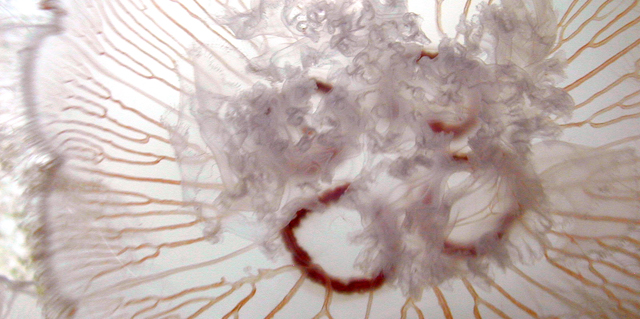 (The
picture to the left is property of Sunset Marine Labs, llc ©
2012) You can clearly see the gonads (reddish-brown circles)
used for primary sex glands and the nerve net is the tan
vein-like lines emerging from the center to the edge of the
bell. (University of Delaware- CEOE website) This nerve net is
the main function as the nervous system for moon jellies since
they have very simple body systems. Rhopalium are the main
sensory structures used to move the bell inward and outward in the "jetting" motion
in order for the Moon Jelly to move in which the picture below
to the left
shows a clear and rare picture of it (courtesy of Alexander
Semenov).
(The
picture to the left is property of Sunset Marine Labs, llc ©
2012) You can clearly see the gonads (reddish-brown circles)
used for primary sex glands and the nerve net is the tan
vein-like lines emerging from the center to the edge of the
bell. (University of Delaware- CEOE website) This nerve net is
the main function as the nervous system for moon jellies since
they have very simple body systems. Rhopalium are the main
sensory structures used to move the bell inward and outward in the "jetting" motion
in order for the Moon Jelly to move in which the picture below
to the left
shows a clear and rare picture of it (courtesy of Alexander
Semenov).
The Moon Jelly stays
pretty close to the surface of the water. You might not know
this, but the moon jelly can only swim horizontally and usually
depends on the flow of th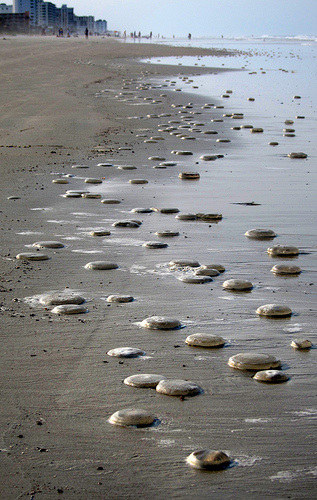 e current to carry them around. The top
of the water also consists of the most abundance of plankton
that also rely on the current to carry them. (marinbio.org) It’s
tragic sometimes when the current
carries these jellies off
shore where they are unable to move and then
dry up or are attacked by birds or/and turtles.(The picture to
the right is property of Joe Burbank.)
e current to carry them around. The top
of the water also consists of the most abundance of plankton
that also rely on the current to carry them. (marinbio.org) It’s
tragic sometimes when the current
carries these jellies off
shore where they are unable to move and then
dry up or are attacked by birds or/and turtles.(The picture to
the right is property of Joe Burbank.)
The Moon Jellyfish mainly feeds on plankton, which are
tiny organisms that float around the ocean water. Plankton can
vary anywhere from tracheal eggs, smalls crustaceans,
diatoms,
and Protozoans. These jellyfish may seem to be non-threatening,
but don’t be mistaken; they are carnivores. A sting from these
jellies
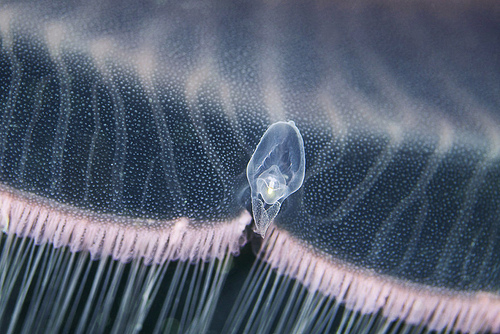 may not harm humans, but they do have mild stinging
nematocysts that they use to paralyze their prey (much smaller
than humans are so
it goes more damage) and then their mucus coating on the outside of
the bell
(the round part) entraps them. Since, the moon
jellyfish doesn’t have a very complex digestive, circulatory
system, or respiration system most of the important functions
occur in the gastrovasular cavity. The food is transported to
the eight distinctive canals, found uniquely to Aurelia aurita,
leading to the gastrovasular cavity for digestion and
absorption. (Marinebio.org)
may not harm humans, but they do have mild stinging
nematocysts that they use to paralyze their prey (much smaller
than humans are so
it goes more damage) and then their mucus coating on the outside of
the bell
(the round part) entraps them. Since, the moon
jellyfish doesn’t have a very complex digestive, circulatory
system, or respiration system most of the important functions
occur in the gastrovasular cavity. The food is transported to
the eight distinctive canals, found uniquely to Aurelia aurita,
leading to the gastrovasular cavity for digestion and
absorption. (Marinebio.org)
Now that we know what
Moon Jellies eat, now we want to know what eats them. The
sea
turtles and large fish generally eat these jellies. At different
stages of their life cycle, they attract different predators.
During the polyp stage, the biggest predator is the Coryphella
verrucosa, while during the medusa stage the Cyanea capillata
is known as the biggest predator (shown in the pictures down
below). (Bishops, Andrew et al, 2005.)
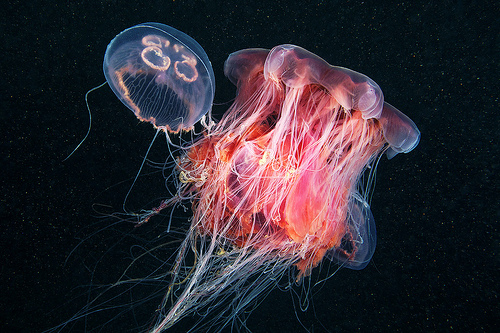
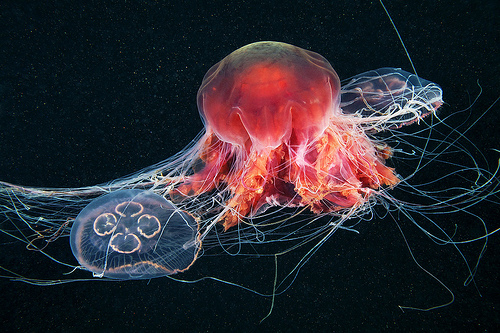
(the above pictures along with the picture on the rhopalium are courtesy of Alexander Semenov)
The moon
jellyfish have long been a nuisance for fishermen. A plan of
attack to decrease the abundance of moon jelly was proposed by
the Japanese Society of Fisheries Science in 2010 to make
Aurelia aurita a main food source for filefish or other
high selling fish in the market. Filefish were separated into
four different feeding types in order to observed body weight
and length between these different feeding types in order to
conclude if the different food sources has any effect on the
fish. These scientists found that feeding only moon jellyfish or
adding the moon jellyfish into the diet plan of these filefishes
has increase their growth rather than just feeding on krill
alone. These experiments show much promise, but need more
extensive research in order to address the issue of the mass
abundance of the moon jellies and their involvement with the bay
areas. (Miyajima, Y.et al. 2011.)
multipleorganisms.net
![]()